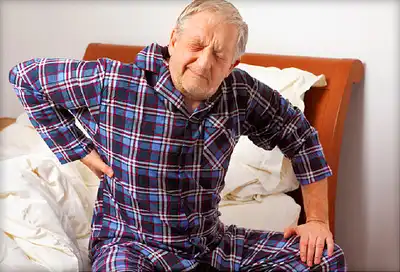This is going to be a two part post the discusses one of the more common ailments that the general public will experience at some point in their life. Working in the outpatient physical therapy world, I personally will see/work with multiple patients throughout the year that have either chronic or acute low back pain. (Chronic refers to pain that you have experienced for many weeks/months/years, whereas acute is a more recent injury)
 |
| Low back pain is common in many people (Image from Google Images) |
These two posts will be more geared toward chronic issues, but can also hit on the acute symptoms you might see.
Part One will discuss common characteristics I see in patient's with chronic low back pain. Part Two will go into detail on a couple different exercises you can try at home to see if your symptoms decrease/resolve.
Posture: A common posture seen in individuals with low back pain is called "lumbar lordosis."
Your lumbar spine refers to the lower section of your spine. You have seven (7) cervical (neck) vertebrae, twelve (12) thoracic (mid-back) vertebrae, and five (5) lumbar (low back) vertebrae.
When you are, for the lack of a better term, "stuck" in lumbar lordosis, you place an increased amount of stress on your low back that continues to build over time.
So what causes this posture? There are a few different things we can point to, but some of the most common are: obesity, osteoporosis (or low bone density), a traumatic injury to the lower back, and/or poor body mechanics with lifting/carrying. On a side note, many women present with lordosis of the lumbar spine when pregnant.
 |
| Lordosis of lumbar spine (Image pulled from Google Images) |
Weakness: Weakness through key muscle groups can cause low back pain, due to lack of spinal stability. Many people are weak through their core and gluteal musculature, which also plays a key part in why many people have low back pain.
If you compare your anterior core (abdominals) with the front brakes of your car, and your glutes as your rear brakes, it can make it a little easier to understand. Majority of people with low back pain are weak in both areas. If both your front and rear breaks are deficient, you won't be able to stop your vehicle and you will be in an accident.
But what if you're strong in one, yet still weak in the other? Then your chances of being involved in a collision (low back pain) go down, but eventually those good breaks will wear down and become weak, so you must perform regular maintenance (exercise) to prevent this from happening. We'll hit more on the exercises in Part Two.
Stresses: Stresses can come in many different shapes and sizes that can contribute to low back pain/symptoms. Ranging from emotional disruptions to physical. I believe the emotional aspect is much more wide-ranging and would love to make a post on it at some time in the future, so I'll hold off on it here. Instead, I'll describe some of the more physical stresses that can lead to low back pain.
The biggest issue I typically see here is repetitive motions/positions that we place are bodies in every day. A lot of times it comes back (pun intended) to what your job duties are. For example, if you have a desk job and are sitting 6+ hours every single day, you are already at an increased risk for something to break down on your body just from the nature of that lifestyle. You may have a tendency to slouch, or rest your elbows on your desk, or lean back in your chair, etc. etc. None of those positions use your spinal stabilizing muscles and will cause that weakness we talked about just moments ago.
On the flip side, you can have a job that results in you standing 6+ hours a day that forces you to place just as much, if not more, stress on your low back. Take your mechanic, who is standing under your car (when it is lifted into the air, or maybe the mechanic is standing down in a drop-floor), and has to reach up over his/her head to reach all the necessary bolts/tubes/wires that make your vehicle function properly. While your reading this, go ahead and put yourself in that position. Look upward and reach into the air like your trying to touch the ceiling/sky. Doing this will increase that curvature in your lumbar spine (lordosis). No imagine doing this for multiple hours a day, five days per week.
This obviously goes for any job that requires repetitive bending/lifting/carrying. If you already have poor posture or weakness through those spinal stabilizers, then throwing extra weight on top of it will only speed up the process.

This obviously goes for any job that requires repetitive bending/lifting/carrying. If you already have poor posture or weakness through those spinal stabilizers, then throwing extra weight on top of it will only speed up the process.

Part One Conclusion: You can see how all three of these things are related in some aspects and how any of the three alone can result in low back pain. Now what can we do to minimize our risk for injuring our low back, if not eliminate the risk all together? I'll dive into that with Part Two of this blog post.
No comments:
Post a Comment